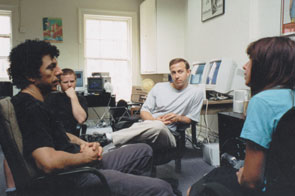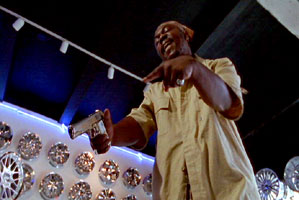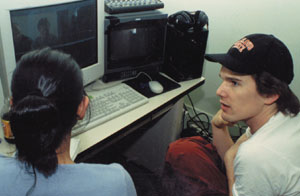DESKTOP REVOLUTION
Just as the word processor replaced the typewriter, nonlinear editing systems have revolutionized film postproduction. Although Avid is the industry standard, increasingly, editors of low-budget films are embracing Final Cut Pro as their system of choice. Scooter McCrae talks with editors at New York’s The Edit Center about the pitfalls of editing DV features using Final Cut Pro and offers two case studies of films currently in postproduction.
Ethan Hawke with a student editor working on Last Word on Paradise.
It was just about 10 years ago that the Avid revolutionized film editing. Just as the word processor replaced the typewriter, nonlinear edit systems like the Avid have replaced the decades-old, somewhat artisanal practice of splicing together strips of celluloid workprint in sequence. The new system came with some tradeoffs – purists missed the tactile quality of cutting with workprint – but before long pretty much every editor, producer and production company had made the switch over to the new hardware.
In retrospect, what’s amazing about this wholesale move is that, largely, it increased, rather than reduced postproduction costs. Avids cost upwards of $100,00 and rent for up to $2,500 a week, whereas an old Steenbeck or KEM rents from $250 to $750 a week. And producers and editors quickly realized that while making a simple cut was indeed quicker on a nonlinear system, it didn’t necessarily translate into shorter postproduction schedules. In fact, even more time in post was needed to truly explore all the possibilities nonlinear systems offer. All of this meant that no-budget indies who shoot their films for $40,000 are suddenly looking for $100,000 or $200,000 of postproduction money.
In the last couple of years there has been a second revolution in the world of independent production: digital video, or DV, has largely replaced 16mm as the format of choice for first-time filmmakers. But one of DVs greatest benefits, the negligible cost of its stock, has increased postproduction costs once again. Every DV filmmaker soon learns that it takes great foresight to realize in postproduction the cost savings provided by DV in production. Because stock is so cheap, filmmakers are encouraged to roll as much of it as possible; DV shooting promises to be lean and mean, so filmmakers are tempted to do away with key positions like the script supervisor, which can mean disorganized footage in postproduction; and since production can be accomplished on something close to a shoestring, first-timers are tempted to believe that post can be too.
The result of these decisions, of course, is often dire. Filmmakers are bogged down with hours and hours of footage and are unable to afford the memory necessary to handle it. Faced with all that footage, experienced editors run for the hills – or, at the very least, refuse to cut their rate. Post stretches on forever.
Enter Alan Oxman and The Edit Center. A year ago Oxman came up with a unique educational program: a respected editor with serious indie cred (Happiness, Two Girls and a Guy), Oxman created a school to teach the art and craft of editing. But rather than teach editing in a dry, academic setting, Oxman replicated for his students the way most independent production folks learn their craft – by doing it. Inviting frugal filmmakers to turn over their unedited footage to his students, Oxman promised filmmakers a rough cut in six weeks and his students the opportunity to cut real features with real talent. So far, Oxman and his fellow editors have taught three courses and have roped in some impressive films for his student editors to cut. Ethan Hawke’s DV feature debut, Last Word on Paradise, was cut by the class as was Wake Up and Smell the Coffee, an Eric Bogosian concert film. "It’s an intense course," says Oxman. "For six weeks you are working full-time, and because you are cutting a real movie you are learning much faster than if you were just reading textbooks."
The economics of DV production, discussed above, are precisely what allows the school to flourish. "It didn’t used to happen that you’d find a movie with a really well known actor that needed this kind of postproduction help," says Oxman. "But there are tons of DV features [being shot] in New York [today] and experienced editors can’t afford to work on them. Our students are able to sit down with Eric Bogosian and discuss how to cut his performance, or work on a scene featuring Natasha Richardson with Ethan Hawke."
What’s really transformed The Edit Center, however, is Oxman’s decision to shift all postproduction work to Final Cut Pro (FCP); while the Edit Center’s first two classes cut on an Avid, the third cut using FCP. Due to the lower equipment costs, Oxman is able to provide more editing systems for the students. Says Oxman, "We switched over [to FCP] because we found that all the really good $100,000-to-$500,000 movies we were being offered were being shot on DV. Because of the ease of importing digital video into FCP and the fact that you can online in the machine, FCP made a lot of sense. And after the first class," he adds, "we just liked it better. It was more accessible to the students and less complicated than the Avid. There’s a huge pool of Avid editors out there; a newcomer is lucky to get an apprentice job. But directors and producers are interested in working on FCP and there are not a lot of editors who know how to use it. So, our students are able to get better jobs after the class."
Oxman cites a growing number of production companies shifting to FCP; Showtime, for example, is now cutting their in-house movies on the system. "It’s truly revolutionary," says Oxman. "You can cut a movie using a G4 Cube," he explains. "If you only use external drives – which is the key – you need to buy about 10 drives, at $600 a piece, to have 750 gigs, which holds about 50 hours of video. The FCP software itself costs about $1,000. Avid software, on the other hand, costs $20,000 to $30,000, and they make you buy proprietary drives and hardware. Because FCP doesn’t involve proprietary hardware and the system costs so much less, you’re not a slave to the high rental cost. You can take time off and go away for the weekend – but take a drive and cut on an iMac."
Because of its emphasis on FCP, The Edit Center is now finding itself sought after as a postproduction house. Seth Schneiderman, a postproduction specialist at Lions Gate Films Releasing, hired Oxman to assemble an editing team of Edit Center graduates to cut Get Down or Lay Down, a thriller starring rapper Jay-Z, on Edit Center equipment. So, The Edit Center now finds itself in the position of being a laboratory for feature solutions on FCP; its editors and students are devising ways to adapt the system for feature production.
Below we’ve assembled the editorial teams from two current Edit Center features – Get Down or Lay Down, directed by Abdul Abbott, and Michael Rauch’s Wake Up and Smell the Coffee, a concert film featuring Eric Bogosian – to present case studies on how they’ve adapted FCP to feature production.
 |
| Eric Bogosian (left) discusses Wake Up
and Smell the Coffee at The Edit Center |
Case Study #1: Wake Up and Smell the Coffee
One of the primary concerns of this project, a live performance by Eric Bogosian captured on DVcam digital video, was media management and communication between its three editors, a director and a performer – Bogosian – who is watching his one-man show suddenly being shaped by outside hands.
Oxman devised an innovative system for organizing the project’s different sets of footage of multi-camera material. No real technical innovations were being explored here, but the equipment involved was definitely pushed to the limits of its printed specifications. Editor Dave Kausch points to the daunting amount of footage he and his colleagues were faced with: "There’s a tremendous amount of material because there were two live shows filmed with five cameras each, and two pick-up shows with five cameras. And the pick-up shows, unfortunately, were not continuous in time code, so there were many small clips that had to be logged. And then there was all the capturing from the 20 DVCam tapes."
Oxman elaborates: "I had the editors do the equivalent of multi-camera mode for the Avid. Let’s say there were four cameras. (There were five, but we generally discarded one of them). The editors loaded the continuous single takes of the show from each of the four cameras into the FCP. They then synched them into quadrants on the screen and then rendered that as an effect. This was then output to a new master so that we had a master tape consisting of all four quadrants together. This was then reloaded into the system as a reference track. As they edited, they put up markers, and the editor went to each track."
Michael Rauch, the director of the show on video (the stage version was directed by Jo Bonney), jumps in with the numbers: "We have over 30 hours of footage for this 85-minute show. So we broke it down into quadrants in order to look at the coverage; it made it easier and quicker [to examine] the choices for the best moments to use."
Kausch adds, "Michael can say, ‘Show me this quadrant from show 1 or that quadrant from show 4.’ He can see what angle he wants to be in, and then we can match the time code on that angle and go and pull the clips. So there was a lot of time spent on the organization; [but] once it was organized the edit went pretty quickly."
Fellow editor Ben Slatkin remembers the process: "We spent two or three days capturing all of the material for a particular scene, and then cut it in a day. We then dumped out the whole show and re-captured it scene by scene." "You could work on that scene, and then you’d get your cut of that scene and save that off and go to the next one," adds Kausch, continuing Slatkin’s thought. "And once we had a rough cut of all of them, we went down and patched them together. We bought these additional external drives after we had done the rough cut and repatched them onto these drives using the trimming tool from FCP and rebuilt a full assembly that we could work over with Mike. That was the first stage. And we showed him that – the 17 different scenes that we had cut out from the show. When you finished your scene, you [simply] picked up the next one on the list and began working on it"
A rewarding aspect of this production is that the editors were invited to attend one of Bogosian’s live performances, which helped them shape the material once the editing process began. Caroline Chiu, the third and final editor, found that "seeing the intensity of Eric’s performance [was] helpful when trying to recapture it in the editing for the audience at home."
In the final edit, Kausch adds, "there’s a dominant performance for each scene; it’s not a shot from show 1 intercut with a shot from show 4. Each individual scene is mostly from one show."
 |
| Scene from Get Down or Lay Down with Jay-Z |
Case Study #2: Get Down or Lay Down
No two projects are ever alike, and in the low-budget arena especially, each one becomes a mathematical experiment in which finances determine the relationship between available resources and affordable scheduling. Unlike the Bogosian project, which was most concerned at the outset with organizing a vast amount of continuously shot footage, Get Down or Lay Down was a more traditional out-of-sequence film shoot.
The film was shot in Super-16mm and will be edited on FCP and then onlined. If a theatrical release is decided upon, output to Hi-Def and then film will follow. Postproduction’s main concern was adapting the FCP system to do something it theoretically should be able to do – generate a usable edit list, or EDL, for conforming film negative – but isn’t widely used for yet. One of the film’s editors, Tim French, is enthusiastic about the possibilities: "We’re doing a lot of extra stuff that you don’t normally do with FCP, like synching [dailies], and we’re finding out how to import Avid List Exchanges (ALE’s) – which is something that you normally do on the Avid. We’re [pioneers in] the invention of the system for using FCP [in feature production], and it’s an opportunity that I don’t think we could have gotten anywhere else."
"FCP, in its beginnings, didn’t have the complicated software program of Film Composer in the Avid – which costs over $50,000," points out editor Paul Frank. "So, because of time and budget constraints we were making our own databases for the purpose of matching back to the negative but, there are third party programs that will do this for you We have heard good things about FilmLogic and there are a couple of others we plan to investigate for future projects "
Says Oxman, "Those Excel lists came back from the lab with complex numbers, and Paul figured out a logical system that translated the telecine numbers and automated the whole process." Get Down or Lay Down was shot using Aaton time code, and the team is both working and theorizing ways to use this code, a FCP database system, as well as the code generated in the telecine, as part of a unified system.
Seth Schneiderman, the film’s postproduction supervisor, adds: "We had a lot of problems with time code breaks, though. What you have to understand when you’re working with FCP (or most non-linear computer editing systems) is that the time code is not being read by every single frame and being listed with it, but it’s read at the head of the clip and then the time code is internally kept within the clip as a counter. So if you have a break in your time code, FCP can’t adjust; it simply lets you know that the code is no longer valid. So you have to prepare your material properly in order to input it."
Which is what they’re doing now, during this interview – transferring DAT tapes to DVcam with new, consistent time code generated on the record deck.
"But on this project," Schneiderman continues, "some of the data got corrupted because the lab didn’t know yet how to use the DVcam with the telecine. It’s the first time they’ve done this kind of transferring. So we went ahead with a very simple, straight-ahead process of synching the film up as if it had been a roll of film and a roll of mag stock – cutting it up and getting it all ready in the computer and then printing it out to a master tape that’s all in sync."
And when the film is cut, what will be the end result? Is there a precedent being established here, or is this an isolated and one-time-only experiment to test resources and budget?
"I talked the people at Lions Gate into trying a film using not only FCP, but a series of different techniques that would result in a better, cheaper production," says Schneider-man, gesturing at all the equipment surrounding us as he speaks. "If this feature is successful enough, or if the distribution people feel it’s worth the gamble and they want to do a theatrical release, we would make the 35mm printing negative by scanning the Super-16mm negative on the Spirit, which is a high-resolution telecine. It’s capable of high definition or even 2K scanning for effects, recording it in high-definition files, probably Quicktime files. There is even a FCP system being tested now at the lab which hopefully will be able to hold and color correct these files; it should be like doing a nonlinear online in high definition. But what makes the whole thing financially feasible are the new high-speed printing devices that scan to 35mm, such as the Arri Laser Printer. Color correction, special effects, titles work – all are being done before final film output in an environment where you can easily see what you are doing."
Nodding in agreement, Justine Harari, an editor at The Edit Center, adds philosophically, "Lions Gate is a big producer of independent features, and they’re taking on FCP as a potential postproduction methodology. So far, it undercuts the cost of a lot of the production methods. In the end it’s really going to revolutionize the independent business even more than all this digital technology has already."
Sidebar: Alan Oxman's Top 10 Final Cut Pro Tips
VOD CALENDAR


 See the VOD Calendar →
See the VOD Calendar →



